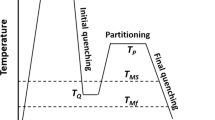Conclusions
-
1.
The ductility of OKh25N12G2T steel decreases at 650–900°C (formation of σ-phase) and at 400–600°C (aging).
-
2.
Aging is due to the precipitation from ferrite of highly dispersed intermetallic phase of the Ni3Ti or Ni3(Ti, Al) type, depending on the amount of residual aluminum. An increase in the concentration of titanium or the quenching temperature increases the degree of hardening.
-
3.
Prolonged tempering at 450–500°C and slow cooling lead to embrittlement at 475°C, which is due to the ordering of the solid solution of chromium ferrite.
Similar content being viewed by others
Literature cited
M. D. Perkas, FMM,15, No. 4 (1963).
É. G. Fel'dgandler and M. V. Pridantsev, Stal' No. 1 (1961).
Additional information
Serp i Molot Plant Translated from Metallovedenie i Termicheskaya Obrabotka Metallov, No. 10, pp. 15–21, October, 1964
Rights and permissions
About this article
Cite this article
Sokol, I.Y. Study of the hardening and embrittlement processes in austenitic-ferritic stainless steels. Met Sci Heat Treat 6, 596–601 (1964). https://doi.org/10.1007/BF00648697
Issue Date:
DOI: https://doi.org/10.1007/BF00648697




